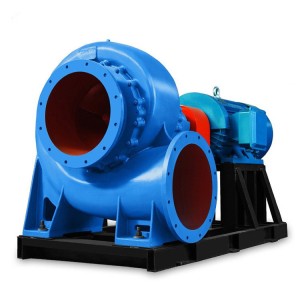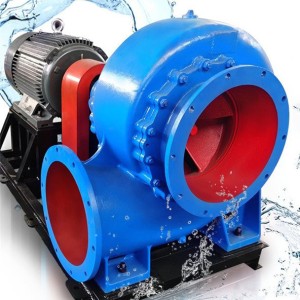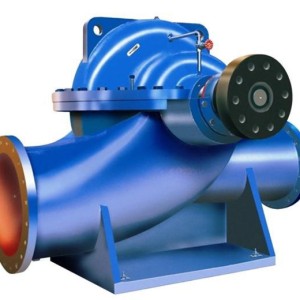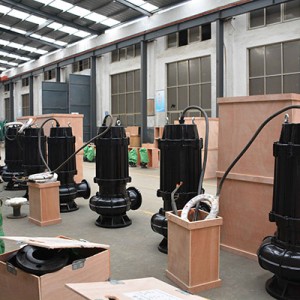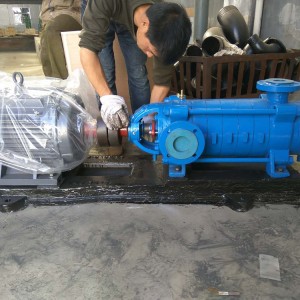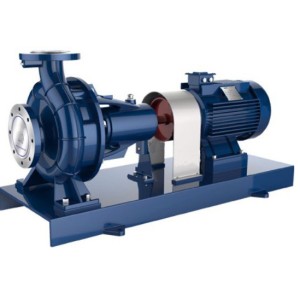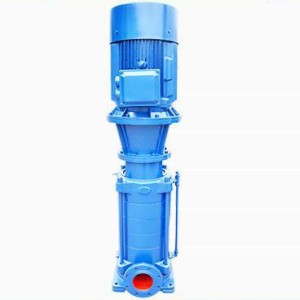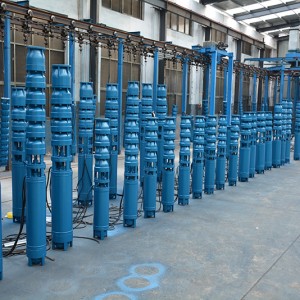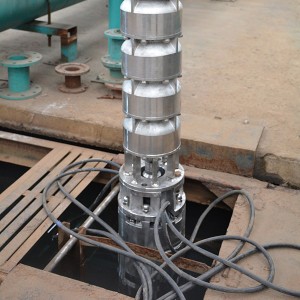1. In terms of the installation technology of the pipeline centrifugal pump, the suction pipeline requires strict sealing, and no air or water leakage, otherwise it will destroy the vacuum at the water inlet of the water pump, reduce the water output of the water pump, and even fail to pump water in severe cases. Come. Therefore, it is necessary to do a good job in the joint work of the pipeline carefully to ensure the construction quality of the pipeline connection.
2. The foundation of the pipeline centrifugal pump should be stable. If the foundation is not well done, the pump will have a great vibration when it starts, which will directly affect the service life of the pump.
3. Determine the height of the water pump device (ie suction stroke). This height refers to the vertical distance from the water surface of the water source to the center line of the pump impeller. It cannot be confused with the allowable suction vacuum height. The allowable suction vacuum height indicated on the pump product specification sheet or nameplate refers to the vacuum value on the section of the water inlet of the pump. And it is measured by stopping the experiment under normal atmospheric pressure and water temperature of 20 degrees Celsius. It did not think about the water flow after the suction pipe was installed. And the height of the water pump device should be the local value left after the vacuum height is allowed to suck up and the loss head of the suction pipe is deducted. It should restrain the actual topographic water absorption height. The height of the pump device cannot exceed the calculated value, otherwise, the pump will not be able to pump water.
4. When the head and water temperature of the pipeline centrifugal pump installation location are different from the experimental conditions, if the local altitude is above 300 meters or the water temperature of the pumped water exceeds 20 degrees Celsius, the calculated value should be corrected. That is, the atmospheric pressure at different altitudes and the saturated steam pressure when the water temperature is higher than 20 degrees Celsius. However, when the water temperature is below 20 degrees Celsius, the saturated steam pressure can be neglected.
5. The size that affects the calculated value is the resistance loss head of the suction pipe. Therefore, it is advisable to use the shortest piping layout and install as few elbow fittings as possible. It is also possible to properly configure a larger diameter water pipe to reduce the flow velocity in the pipe.
6. The key to the installation technology of the pipeline centrifugal pump is to determine the installation height of the pump (ie suction lift). This height refers to the vertical distance from the water surface of the water source to the center line of the pump impeller. It cannot be confused with the allowable vacuum height. The allowable vacuum height indicated on the pump product manual or nameplate refers to the vacuum value on the section of the water inlet of the pump, and It is measured under 1 standard atmosphere pressure and water temperature of 20 degrees Celsius. It does not consider the water flow after the suction pipe is installed. The installation height of the water pump should be the value of the remaining part of the value after the vacuum height is allowed to suck up and the loss of the suction pipe is deducted. It must overcome the actual topographic water absorption height. The installation height of the pump should not exceed the calculated value, otherwise, the pump will not be able to pump water. In addition, the magnitude that affects the calculated value is the resistance loss head of the suction pipe. Therefore, it is advisable to adopt the shortest pipeline layout and install as few fittings as elbows. It is also possible to consider appropriately matching larger diameter water pipes to reduce the flow velocity in the pipe. It should be pointed out that when the elevation and water temperature of the pipeline centrifugal pump installation site are different from the test conditions, if the local altitude is more than 300 meters or the pumped water temperature exceeds 20 degrees Celsius, the calculated value must be corrected. That is, the atmospheric pressure at different altitudes and the saturated steam pressure when the water temperature is higher than 20 degrees Celsius. However, when the water temperature is below 20 degrees Celsius, the saturated steam pressure is negligible. From the perspective of pipeline installation technology, the suction pipeline requires strict sealing, and no air or water leakage, otherwise it will destroy the vacuum at the water inlet of the pump, reduce the water output of the pump, and even fail to pump water in severe cases. Therefore, it is necessary to do a good job in the interface of the pipeline to ensure the quality of the pipeline connection.
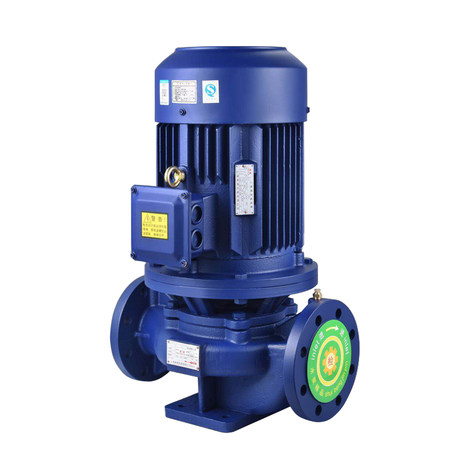
2. Calculation of installation height Hg of centrifugal pump
The allowable vacuum height Hs refers to the maximum vacuum that can be reached by the pressure p1 at the inlet of the pump. The actual allowable suction vacuum height Hs value is not a value calculated according to the formula, but a value determined experimentally by the pump manufacturer. This value is attached to the pump sample for users to check. It should be noted that the Hs value given in the pump sample is the value when clean water is used as the working medium, and the operating condition is 20℃ and the pressure is 1.013×105Pa. When the operating conditions and working medium are different, conversion is required.
(1) Transport clean water, but the operating conditions are different from the experimental conditions. It can be converted according to the following formula: Hs1=Hs+(Ha-10.33)-(Hυ-0.24).
(2) Transporting other liquids. When the conditions of the liquid to be transported and the villain are different from the experimental conditions, a two-step conversion is required: the first step will be the Hs1 found in the pump sample according to the above formula; the second step will be the Hs1 according to the following formula Converted to H?s 2 NPSH Δh For oil pumps, when calculating the installation height, use the NPSH Δh to calculate, that is, the degree of vacuum that the pump allows to suck liquid, that is, the allowable installation height of the pump, in meters. Use the NPSH Δh to check from the oil pump sample, and its value is also measured with 20℃ clean water. If other liquids are to be transported, calibration is also required, and the relevant books should be checked in detail. Suction range = standard atmospheric pressure (10.33 meters)-cavitation margin-safety amount (0.5 meters) standard atmospheric pressure energy pressure pipeline vacuum height 10.33 meters.
For example: a pump must have a NPSH of 4.0 meters. Find the suction stroke Δh? Solution: Δh=10.33-4.0-0.5=5.83 meters. From a safety point of view, the actual installation height of the pump should be less than the calculated value. When the calculated Hg is negative, it means that the suction port of the pump should be below the liquid level of the storage tank.
Example 2-3 A centrifugal pump found from the sample that the allowable vacuum height Hs=5.7m. It is known that the total resistance of the suction pipeline is 1.5mH2O, the local atmospheric pressure is 9.81×104Pa, and the dynamic pressure head of the liquid in the suction pipeline can be ignored. Trial calculation:
(1) Pump installation when delivering 20℃ clean water;
(2) Change to the installation height of the pump when delivering 80℃ water.
Solution: (1) The installation height of the pump when delivering 20℃ clean water is known: Hs=5.7m Hf0-1=1.5m u12/2g≈0 The local atmospheric pressure is 9.81×104Pa, which is basically consistent with the experimental conditions when the pump leaves the factory, so The installation height of the pump is Hg=5.7-0-1.5=4.2 m. (2) Pump installation height when delivering 80°C water. When delivering 80°C water, the Hs value in the pump sample cannot be directly used to calculate the installation height. The Hs time must be converted by the following formula, that is, Hs1=Hs+(Ha-10.33) -(Hυ-0.24) Known Ha=9.81×104Pa≈10mH2O, the saturated vapor pressure of 80℃ water is 47.4kPa found from the appendix. Hv=47.4×103 Pa=4.83 mH2O Hs1=5.7+10-10.33-4.83+0.24=0.78m Substitute the Hs1 value into the formula to obtain the installation height Hg=Hs1-Hf0-1=0.78-1.5=-0.72m Hg is A negative value means that the pump should be installed below the liquid level of the pool, at least 0.72m lower than the liquid level.
Post time: 2021-12-02


